Post by aerofoto - HJG Admin on Dec 18, 2007 8:24:50 GMT
Despite a proliferation of new jetliner orders which punctuated the late 1950's, DC8 production (like that of the B707) began declining alarmingly throughout the early 1960's. At one stage it seemed likely production would terminate with less than 300 aircraft having been built. Most of the world’s major airlines had invested heavily in new jet equipment to remain competitive and meet an anticipated travel boom. Many airlines were instead confronted with excess capacity during early years of the new decade as projected traffic growth was slower developing than previously forecast. Fortunately for Douglas, the burgeoning market in jet air freight and development of its DC8 JET TRADER encouraged sufficient orders to sustain DC8 production throughout this slack period until traffic growth caught up with capacity and airlines could justify ordering new aircraft. By the mid 1960's traffic was on the rise and before the end of the decade greater capacity and longer range were becoming priorities of an airline industry struggling to cope with increasing airport congestion and the need to fly greater payloads further. To address these challenges Douglas began surveying needs of the industry and re-evaluating its DC8 design accordingly to make the aircraft more competitive with B707 and extend the types production life. These studies spawned the next DC8 generation ...the "SUPER 60" series... in the form of larger DC8-61, -62, & -63 jetliners of superior performance to their type predecessors.
This new program was officially launched on April 4 1965 with an order for 4 DC8-62's from SAS. It was quickly followed by orders for 5 DC8-61's from United Air Lines, then 8 -61's from Eastern Airlines... with many other carriers contracting promptly thereafter. Producing the DC8 with a standard fuselage length despite considerable growth potential designed into the aircraft from the beginning (long legs with a 63in ground clearance) had somewhat impaired success of DC8 sales. However, given the phenomenally high cost of developing new jet aircraft and the company's less fortunate financial status (having to relocate from Santa Monica to Long Beach California and erect new production facilities in support of its initial Dc8 program ...which the company needed to fund independently along with DC8 development, loosing its bid for the USAF KC135 contract, and commencing studies into jet development much later) in comparison with more affluent Boeing, it is doubtful that Douglas could have afforded to develop and market a larger aircraft sooner without threatening its own viability in the aviation market place. As it came to pass, during the mid 1960's the company was forced to seek a partner with whom to merge in order to continue financing and marketing its new DC8 SUPER 60, DC9, and wide-body DC10 programs. This resulted in a merger between Douglas Aircraft Company and McDonnell Aircraft Corporation on April 28 1967 and adoption of a new corporate name ..."McDONNELL DOUGLAS AIRCRAFT COPORATION".
Whilst DC8 production lagged behind that of the B707, Douglas's extensive experience in both civil aircraft development and the world airline industry had influenced then less experienced Boeing to improve its jetliner accordingly. Benefiting from huge military/government investment (USAF KC135 contract) Boeing was advantaged by its ability to offer better sales terms for B707's and generate sales/production rates which exceeded those for DC8's. Boeing could also later more soundly afford to finance not just its B707 program, but, a whole new family of short, medium, and long range/intercontinental jetliners aimed to suit the future requirements of the worlds airlines. Many clients were however profoundly loyal to Douglas and with development of the new SUPER 60's family, the DC8 for the first time in its production life, suddenly had no direct rival in the B707 or any other long range/intercontinental civil aircraft, until advent of the wide-body A300, B747, DC10, & L1011 jetliners which entered service during the early 1970's. The B707 design was not as adaptable to the DC8's "stretching process". Boeing's only practical response was to reconfigure its B707-320C for up to 219 PAX at reduced seating pitch. Throughout the final years of the 1960's, McDonnell Douglas had both high density and ultra long range/intercontinental aircraft markets almost entirely to itself. DC8 SUPER 60 series jetliners provided most airlines the best intermediate solution to their logistical needs until arrival of larger wide-body aircraft. DC8 sales/production advanced as a result, but, lacking Boeing's significant military investment, along with financial strains imposed by developing and marketing 3 major aircraft types, supply problems throughout the period of the Vietnam war, and other commercial/political issues which arose during the late 1960's, all combined to severely tax the new corporations resources to limit its economic success despite the abundance of new aircraft orders that followed.
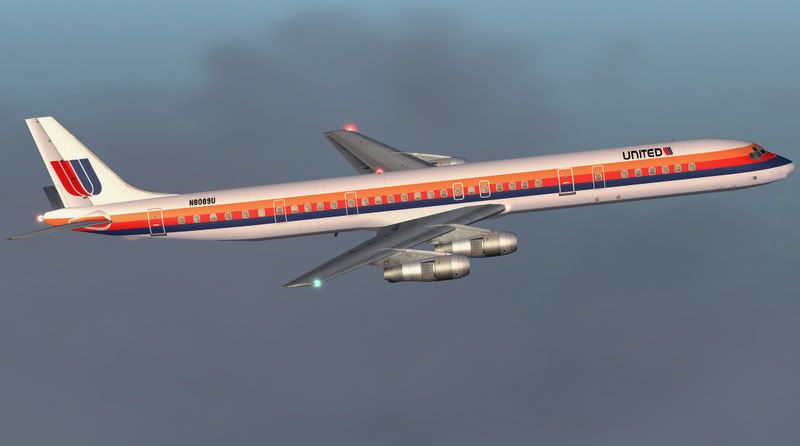
"DC8 SUPER 61" was first of the new family of Stretched DC8 aircraft. This version combined 2 fuselage plugs stretching the body 36ft 8in with the standard wing and fanjet engines from the DC8-50 series, offering 45% greater capacity and better economics for a slight range penalty. It was produced in both PAX and convertible versions.

Convertible models (capitalizing on Douglas's successful DC8 JET TRADER) featured the same 140in X 86in port side forward fuselage main-deck cargo door of DC8-50F aircraft for flexible or mixed PAX/freight operations with capacity for 4 to 18 LD3 containers or up to 75,000lbs of cargo. All SUPER DC8 series aircraft featured enlarged 56in X 60in starboard side lower fuselage baggage/freight hatches with upward sliding doors and strengthened center sections with thicker skin and frame modification to withstand flexing imposed upon the elongated fuselage in-flight. Despite the increased size some 2,000lb were shed from the weight of the larger structure (substituting some interior metal components for plastic substitutes) in order to certify the aircraft according to DC8-55F MTOW, though flight testing later proved the aircraft substantially more capable. Additional forward and rear emergency exits were incorporated into the longer fuselage to comply with FAA emergency evacuation regulations and the aircrafts greatly enlarged capacity. The location of both these exits and cabin window configuration on some aircraft varied according to airline specifications. DC8-61 improvements included a revised cabin air conditioning system to more efficiently service the aircrafts greater interior volume, enlarged leading edge wing slots, minor revisions to the flap system, and a DC9 type flight deck which became a standard feature of all production DC8-60 type aircraft. The very first DC8 SUPER 61 was rolled out at the Douglas Long Beach California plant on January 24 1966. It first flew on March 14 1966. Flight testing revealed slightly improved T/O performance/reduced field length requirement, slightly less noise, enhanced climb characteristics, greater in-flight stability than previous DC8-50's, and slightly shorter landing roll. Performance and reliability evaluation of DC8-61 were conducted between August 16 1966 and August 18 1966 with a test flight from Long Beach to Tokyo, operated in 11 hrs 50 mins, then Tokyo to Winnipeg, operated in 11 hours. The FAA certificate for the standard DC8-61 was approved on September 1 1966, followed by certification for the -61CF model on June 11 1967. United Air Lines took delivery of the first DC8-61 (L/n #252) on May 7 1967, followed by the first -61CF which was delivered to Trans International Airlines on June 16 1967. Prior to service entry and much to the concern of contracting airlines, DC8-61's were under threat of being banned from some airports around the world due to misconceptions by both noise lobbyists and airport authorities whom were initially concerned by prospective impact of such a large aircraft upon surrounding airport environments and existing airport facilities. The DC8-61 was ultimately proven less noisy than DC8 JET TRADER aircraft and increasing ground support services associated with aircraft turnarounds considerably minimized impact upon airport resources. A total of 88 DC8-61's were produced by McDonnell Douglas. 10 of these were built as CF models.
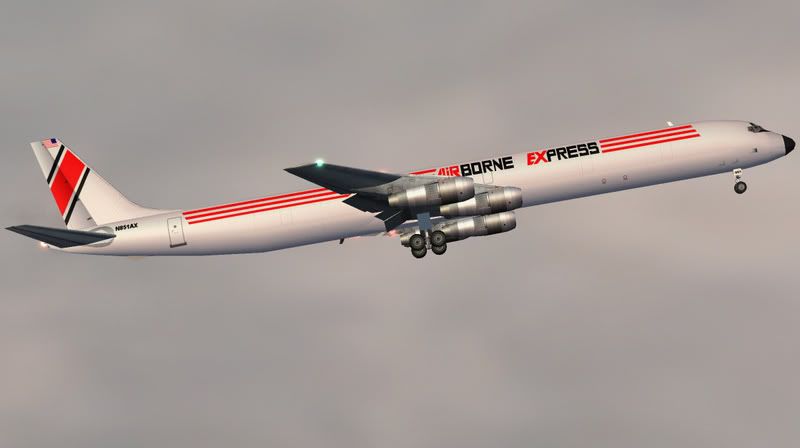
Although originally offered by Douglas, DC8-61's were never produced as pure freighters. Upon conclusion of their PAX service a number of these aircraft were converted to freighters during the late 1970's, re-designated DC8-61F such as those which served Air Transport International, Airborne Express, Fine Air and others. These aircraft mostly featured plugged cabin windows and had capacity for 18 LD3 containers or payloads of up to 88,490lbs. 53 DC8-61's were later upgraded to -71 and -71CF aircraft during the early 1980's, re-engined with quieter, more powerful, and fuel efficient CFM56 hi-bypass fanjets. Many of these aircraft still remain in service today with major freight operators around the world. All DC8-61 aircraft had a fuselage length of 187ft 4in, wingspan of 142ft 5in, capacity for 210 PAX in a dual First/Economy Class layout or up to 269 PAX in a Super Economy Class cabin (depending on airline/aircraft configuration), and range of some 3,256nm (depending on payload and reserves). Standard DC8-61's had a MTOW of 325,000lbs whilst both convertible -61CF and pure freight -61F models were certified for up to 328,000lbs. All series -61 DC8's were powered by 4 P&W JT3D-3B fanjet engines each rated at 18,000lbs/st.
Parallel to developing DC8-61 for high density medium/transcontinental operations, Douglas also sought to address ultra long range/intercontinental markets. European carriers wanted an aircraft capable of flying non-stop and with a full payload between the continent and US West Coast. Re-evaluation of the DC8's aerodynamic efficiency in order to increase range and compete more effectively with B707-320C became the company's priorities in response to this request, which evolved into both DC8 SUPER 62 and -63 jetliners.
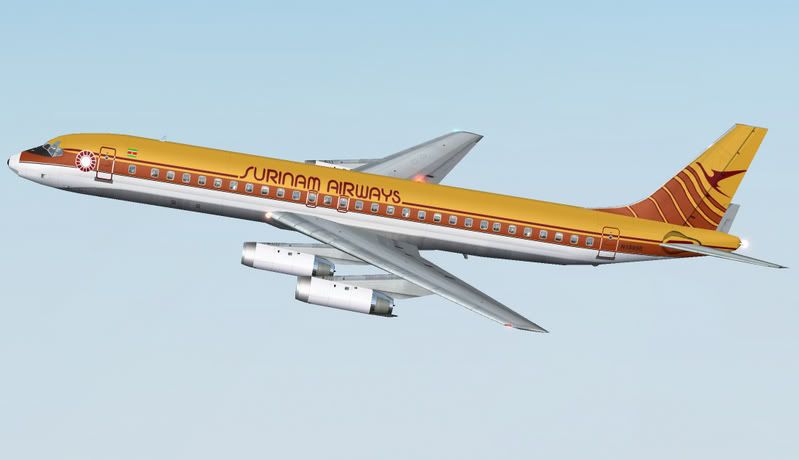
The "DC8 SUPR 62" featured a 6ft 8in fuselage stretch beyond the length of a standard DC8 series combined with major aerodynamic modifications. These included redesigned 3ft wing tip extensions, which increased overall wingspan by 6ft, promoted additional fuel capacity for longer range, and reduced drag. Redesigned and streamlined long duct engine nacelles which channeled air more efficiently through the engines and were 8in shorter and 12% narrower than standard DC8-50/61 type P&W JT3D type nacelles and also promoted reduced drag, these engines were also fitted with aft mounted thrust reversers comprising of 2 rotating/sideways opening clamshell type buckets which redirected thrust forwards/sideways to assist deceleration during roll-out after landing. Redesigned engine pylons which were both longer and narrower than previous standard DC8 type pylons, with leading edge sleeves attaching below rather than above wing leading edges and which also repositioned engine nacelles 40in further forward to yet further reduce drag. These combined technical and aerodynamic enhancements helped extend range beyond 5,000nm and promoted a 10,000lb increase in MTOW. During mid 1964, DC8-54JT N109RD was temporarily employed as a test bed for trials evaluating performance/efficiency of the new long duct engine nacelles which were hung on standard pylons. Throughout the test program this particular aircraft featured a hybrid livery comprising of Airlift International fuselage striping with "DOUGLAS DUCTED FAN DC-8" titles, and "DOUGLAS FAN JET" titles and stripping applied to each engine nacelle. Upon successful conclusion of the flight analysis program this aircraft was converted back to standard DC8-50/61 type P&W JT3D engine configuration then delivered to Airlift International on June 17 1964. Other DC8-62 improvements included fitting a 55in cone inside the tail pipe of each engine nacelle to better mix air and exhaust streams and suppress noise, lighter main gear bogies, altering wing flap detents from what had been standard 10/15/25/35/50 settings to 10/18/23/35/50 detents and slight lengthening of leading edge wing slots, implementation of the same cabin air conditioning system applied to DC8-61, and at least 1 additional aft fuselage located emergency exit on both port and starboard sides. The very first DC8 SUPER 62 was rolled-out on June 28 1966. It first flew on August 29 1966. Initial flight testing revealed further improved T/O performance, 2,000ft less field requirement than DC8-50, 2.5 to 4.5 decibels less noise, and 8.5% less fuel burn. No problems were encountered until later testing when airspeed was gradually increased beyond 418kts, at which point severe wing flutter was experienced. This was traced to the new pylon design and resolved by modifying the aircrafts fuel management system for retention of reserve fuel in the aircrafts wing tip tanks which ensured adequate wing stiffness throughout all flight/speed regimes.
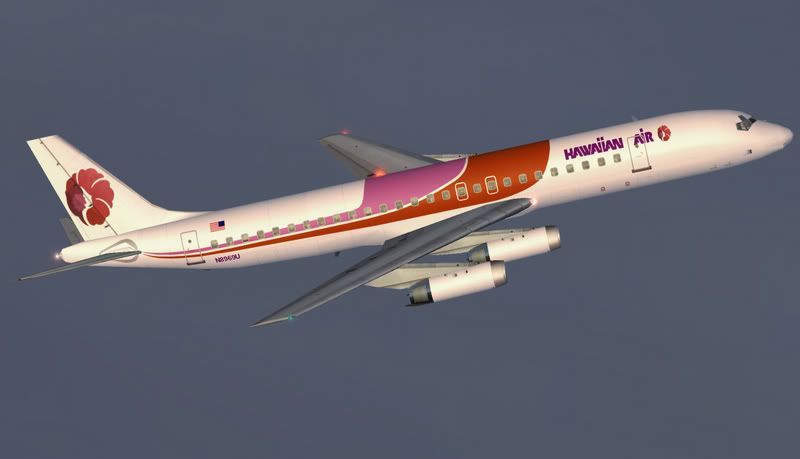
During December 1966 testing the very first T/O at 350,000lbs was successfully performed, in advance of certification for the high gross weight DC8-62H. The DC8 SUPER 62 was produced in standard PAX, convertible PAX/freight, high gross weight, and pure freight versions. Both convertible and freight models also featured the port side forward fuselage main-deck cargo door of earlier DC8 JET TRADER's.
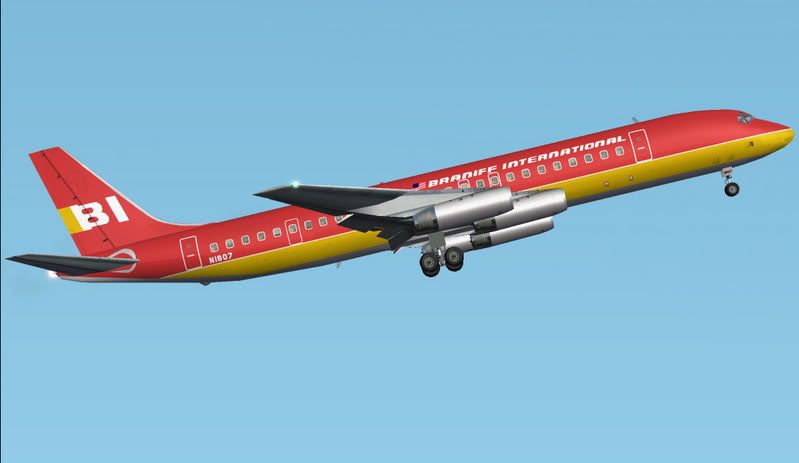
CF models had flexible or mixed PAX/freight capacity for 4 to 14 LD3 containers or payloads of up to 90,700lbs of cargo.
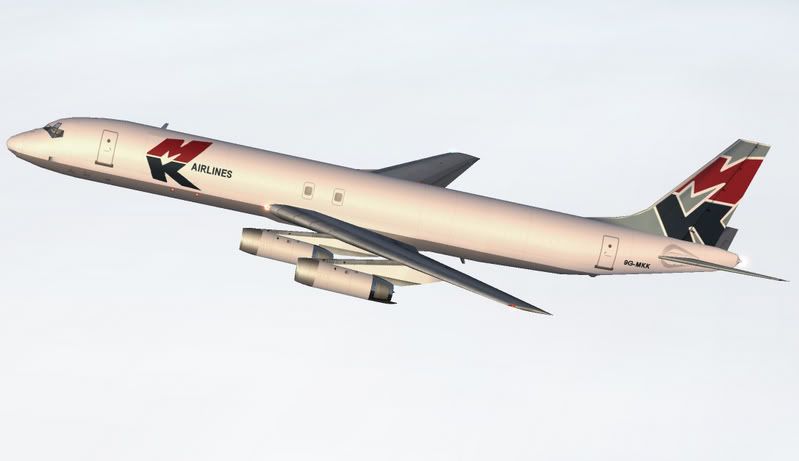
AF models were devoid of fuselage cabin windows and stripped of all PAX furnishings for cabin interiors equipped with a reinforced main-deck, roller floor, guide rails, tie down points, 9G crash netting and had capacity for 14 LD3 containers or payloads of up to 91,440 lbs. FAA certificates for the standard DC8-62 and high gross weight -62H were both approved on April 27 1967, followed by certification for both -62CF and -AF versions on April 9 1968. SAS took delivery of the first DC8-62 on May 3 1967 (L/n #279), followed by the first -62CF which was delivered to Braniff International Airways on November 16 1967 (it could only be operated in basic -62 configuration prior to FAA approval), and Japan Air Lines accepted the first -62AF on September 14 1970. In commercial airline service DC8-62's earned the prestigious title of being "the worlds longest ranging jetliner", an attribute retained well into the 1980's. A total of 67 DC8-62's were produced by McDonnell Douglas. These included 51 standard PAX configured -62 (of which 20 were high gross weight -62H), 10 convertible -62CF, and 6 pure freight -62AF aircraft.
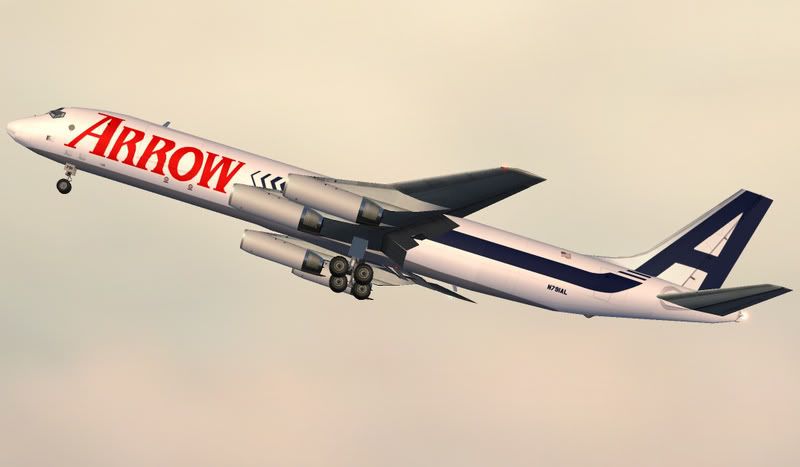
Upon conclusion of their PAX service many DC8-62's were converted to pure freighters during the late 1970's and operated by numerous carriers around the world, re-designated DC8-62F such as those which served Arrow Air, Canarias Cargo, Emery Airfeight and others. A very small number of these aircraft remain in service with freight operators today featuring hush-kitted P&W JT3D fanjet engines. Only 7 DC8-62's were ever upgraded to -72 and -72CF series aircraft during the early 1980's, again re-engined with quieter, more powerful, and fuel efficient CFM56 hi-bypass fanjets. Most of these aircraft also still remain in service today as private/corporate transports. All DC8-62 aircraft had a fuselage length of 157ft 5in, wingspan of 148ft 5in, capacity for 189 PAX in a dual First/Economy Class layout (depending on airline/aircraft configuration) and improved seating pitch over that of the DC8-50 series, and range of some 5,210nm (depending on payload and reserves). The standard DC8-62, convertible -62CF, and pure freight -62AF & F models each had a MTOW of 335,000lbs whilst the high gross weight -62H model was certified for up to 350,000lbs. All DC8-62, -CF, and -AF models were powered by 4 P&W JT3D-3B ducted fanjet engines each rated at 18,000lbs/st whilst high gross weight -62H aircraft had more powerful P&W JT3D-7 engines rated at 19,000lbs/st.
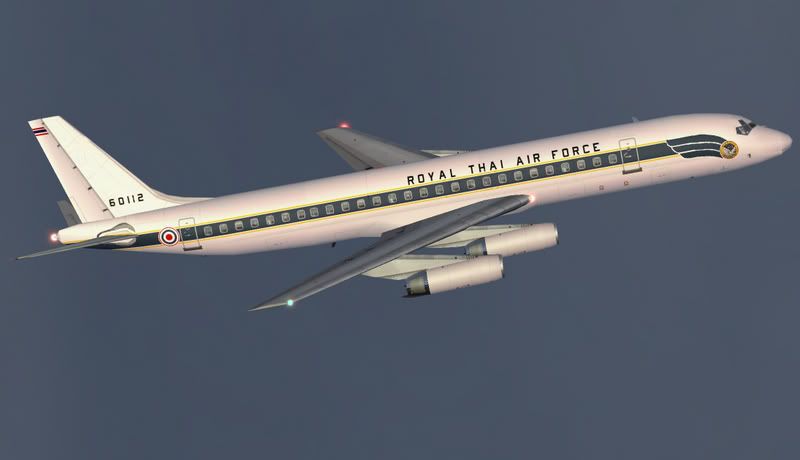
During 1968 yet another attempt was made by McDonnell Douglas to interest the military in DC8 aircraft. This time in response to a USAF AWACS requirement and based on the DC8-62 airframe. Despite producing a mock-up of the proposed DC8 AWACS and significant interest being fostered by the military, the production contract for AWACS aircraft was awarded to Boeing when the USAF elected to once again retain its established B707 derived C135 type airframe. A small number of DC8-62CF aircraft did later enter military/government service as VIP/general transport aircraft with air forces around the world, such as the Armee de l'air, Fuerza Aerea del Peru, and Royal Thai Air Force.
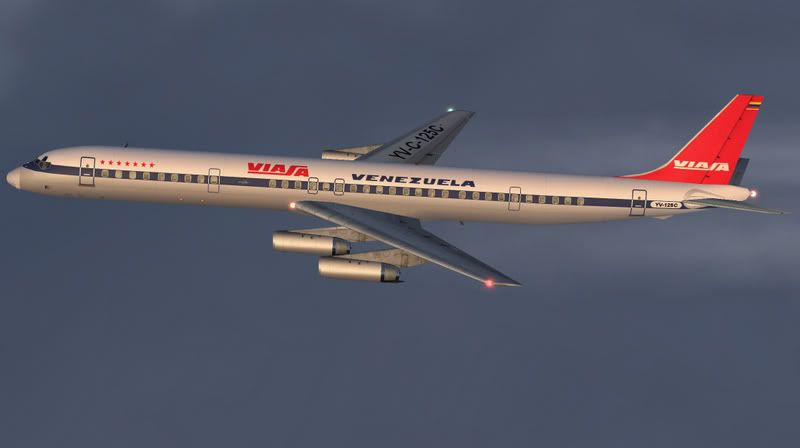
Combining DC8-61's high capacity stretched fuselage with the -62's extended wing and aerodynamic enhancements, and more powerful P&W ducted fanjet engines, along with other general improvements applied to both DC8-61 & -62 designs resulted in the "DC8 SUPER 63". This particular aircraft became the final, definitive, and most successful production model of the entire DC8 family. Intended for high density long range/intercontinental operations it ushered in the concept of mass market/bulk air travel prior to introduction of wide-body jetliners. The DC8 SUPER 63 was produced in 4 basic versions with varying configurations and MTOW capabilities. These included the standard PAX configured DC8-63, convertible -63CF, pure freight -63AF, and the high gross weight -63PF. Following established Douglas practice with its preceding DC8 line, both -63CF & -63AF aircraft also inherited the DC8-50 JET TRADER's port side forward fuselage main-deck cargo door and were strengthened for higher payloads than the standard DC8-63’s.
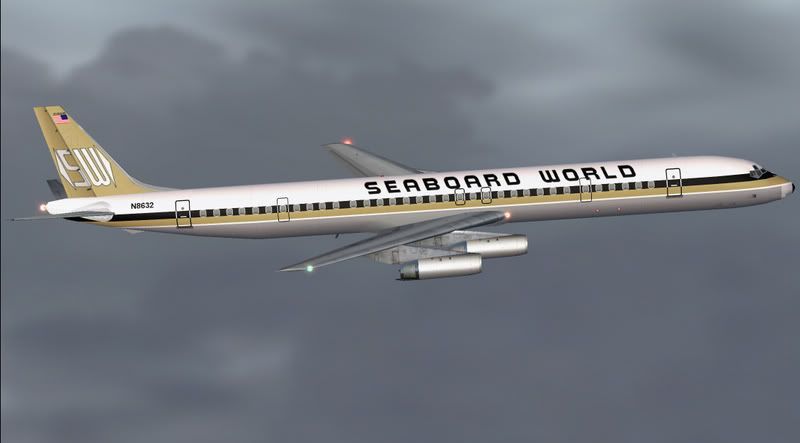
CF aircraft interiors were again designed to be convertible promoting flexible or mixed PAX/freight operations with capacity for 4 to 18 LD3 containers or payloads of up to 112,000lbs of cargo.
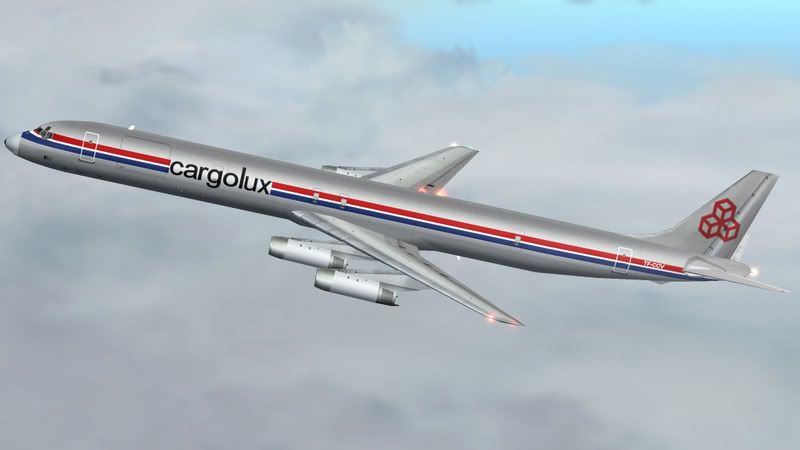
The interiors of AF aircraft again purposely lacked passenger furnishings and were equipped with customized freight handling equipment for dedicated air cargo operations with capacity for 18 LD3 containers or payloads of up to 116,000 lbs.
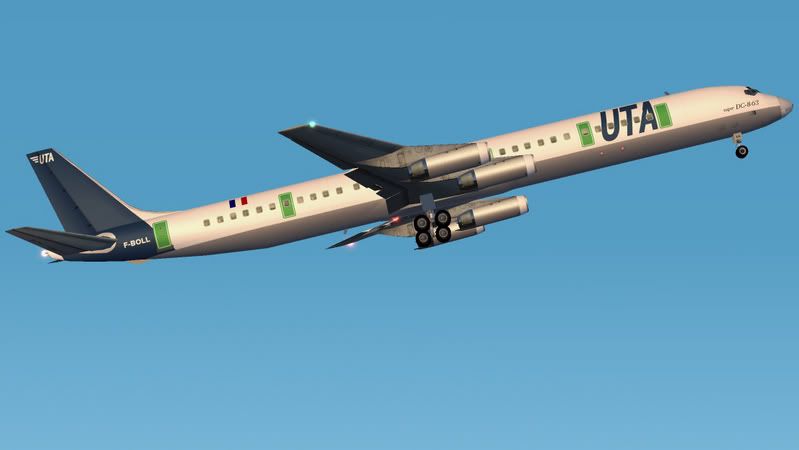
PF aircraft were essentially standard PAX configured DC8-63's strengthened to CF/AF aircraft specifications but lacked the heavy forward fuselage main-deck cargo door and associated mechanism, as it was intended for these versions to make future conversion to pure freighters with relative ease and economy. Prior production of the very first airframe the Dc8-63 also came under threat of potential airport bans/restrictions, this time due to the aircrafts higher operating weights which were anticipated to likely exceed permissible bearing limits of established runways/taxiways. This prompted a late redesign of the main gear trucks for all DC8-63's, resulting in slightly larger main gear tires being fitted and with fractionally wider spacing to reduce the aircrafts footprint. The very first DC8 SUPER 63 was rolled out on March 6 1967. It first flew on April 10 1967. In comparison with DC8-62 performance, initial preflight analysis of the -63 design indicated potential for an estimated 5% range penalty due to natural drag imposed by the aircrafts elongated fuselage. Flight testing later proved any such range impairment was no more than 2%. During later testing T/O weights of up to 361,150lbs were performed, as were landing weights of up to 355,400lbs in order to analyze breaking efficiency under high gross weight operating conditions. The FAA certificate for the standard DC8-63 was approved on June 29 1967, followed by certification for the -63CF, -63AF, and -63PF versions on June 10 1968. KLM Royal Dutch Airlines took delivery of the first DC8-63 (L/n #286) on July 18 1967, followed by the first -63CF which was delivered to Seaboard World Airlines on June 21 1968, then the first -63AF which was accepted by Flying Tigers on October 18 1968, and Eastern Airlines received the first -63PF on February 24 1969. In commercial airline service DC8-63 aircraft proved exceptionally popular despite the need to revise the breaking system on early production aircraft due to difficulties experienced decelerating in wet conditions and at high gross landing weights. In particular, lifting capabilities of both DC8-63CF and AF versions were impressively demonstrated by supplemental carriers with logistical/supply commitments to the US military throughout the period of the Vietnam war. A total of 107 DC8-63's were produced by McDonnell Douglas. These included 41 standard -63, 53 convertible -63CF, 7 pure freight -63AF, and 6 -63PF aircraft.
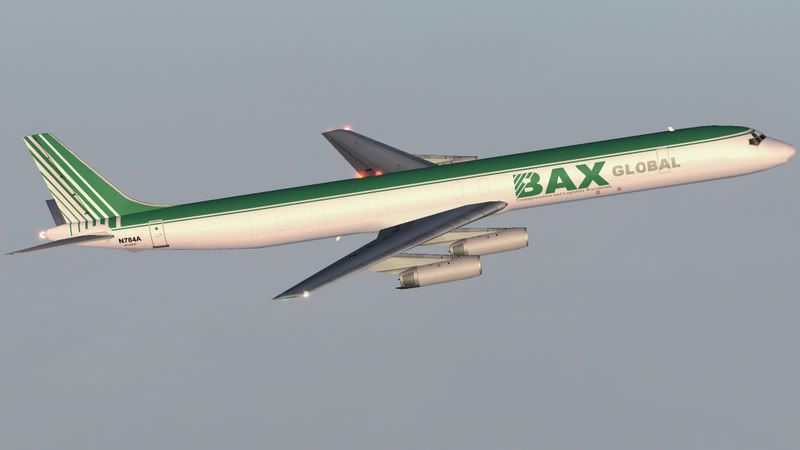
As with preceding DC8 type models, at the conclusion of their PAX service many DC8-63's were converted to pure freighters during the late 1970's and operated by numerous carriers around the world, re-designated DC8-63F such as those which served DHL/ABX Air, Evergreen International, MK Airlines and others. A few of these aircraft remain in service with freight operators today featuring hush-kitted P&W JT3D fanjet engines. 50 DC8-63's were later upgraded to -73, -73CF, and -73F series aircraft during the early 1980's, re-engined with quieter, more powerful, and fuel efficient CFM56 hi-bypass fanjets. Many of these aircraft also still remain in service today with major freight operators around the world. All DC8-63 aircraft had a fuselage length of 187ft 4in, wingspan of 142ft 5in, capacity for 210 PAX in a dual First/Economy Class layout or up to 269 PAX in a Super Economy Class cabin (depending on airline/aircraft configuration), and range of some 4,110nm (depending on payload and reserves). Standard DC8-63's had a MTOW of 350,000lbs whilst convertible -63CF, pure freight -63AF& F, and -63PF models were all certified for up to 355,000lbs. A few very early production DC8-63's were powered by 4 P&W JT3D-3B ducted fanjet engines rated at 18,000lbs/st but the majority of these aircraft had more powerful P&W JT3D-7 engines rated at 19,000lbs/st.
Developing the DC8 and competition with B707 became a prohibitively expensive ordeal for Douglas. Need to constantly refine DC8 design in order to gain competitive edges pushed break-even points further into the future, a financial imposition Douglas, unlike Boeing, was less able to offset. Developing the SUPER 60 series became the saving grace for the DC8 line, escalating production to a respectable 556 aircraft, but, it is doubtful the DC8 program ever returned a profit. The incredible pace of DC8 sales/production between 1967 and 1969 was spectacular but short-lived. By 1969 the wide-body jetliner era was about to dawn and this resulted in progressive decline of DC8 sales/production rates until 1972. By this time McDonnell Douglas was eager to close its DC8 line in anticipation of DC10 production.

The last ever DC8 to roll off the McDonnell Douglas production line at Long Beach California was a standard DC8-63 for SAS. This particular aircraft (SE-DBL "Tord Viking", C/n 46163, L/n #556) first flew on April 4 1972 and was delivered to the airline on May 12 1972.

Between 1982 and 1988 it also saw service with SAS subsidiary Scanair (renamed "Bodil Viking").
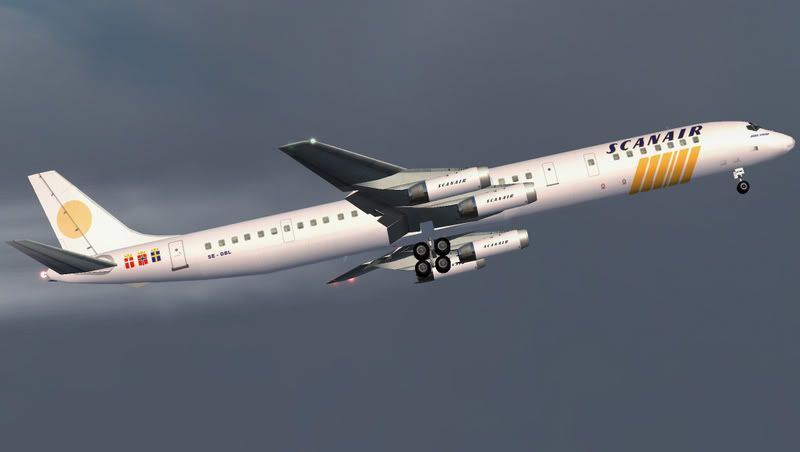
The aircraft was later sold and converted to a freighter then operated by Emery Airfreight (N797AL) from August 1989 until May 30 2000 when it was finally retired from service.

This aircraft is now owned by International Air Response and remains in storage at Victorville California.
Closing the line was by no means the end of the DC8 saga. These aircraft flew on through the soaring 70's, into the advanced 80's and high-tech 90's, and have continued operating successfully into this new millennium. Despite rising fuel costs and implementation of more stringent FAA noise regulations, the durability and flexability of the DC8 has prevailed to ensure survival well beyond that of its more commercially successful civil B707 rival. By far the majority of DC8's flying today are re-engined with advanced, environmentally friendly CFM56 hi-bypass fanjets, the "SUPER 70 SERIES", but that's still yet another tale to be told!
By Mark CRANSTON & Dee WALDRON
This new program was officially launched on April 4 1965 with an order for 4 DC8-62's from SAS. It was quickly followed by orders for 5 DC8-61's from United Air Lines, then 8 -61's from Eastern Airlines... with many other carriers contracting promptly thereafter. Producing the DC8 with a standard fuselage length despite considerable growth potential designed into the aircraft from the beginning (long legs with a 63in ground clearance) had somewhat impaired success of DC8 sales. However, given the phenomenally high cost of developing new jet aircraft and the company's less fortunate financial status (having to relocate from Santa Monica to Long Beach California and erect new production facilities in support of its initial Dc8 program ...which the company needed to fund independently along with DC8 development, loosing its bid for the USAF KC135 contract, and commencing studies into jet development much later) in comparison with more affluent Boeing, it is doubtful that Douglas could have afforded to develop and market a larger aircraft sooner without threatening its own viability in the aviation market place. As it came to pass, during the mid 1960's the company was forced to seek a partner with whom to merge in order to continue financing and marketing its new DC8 SUPER 60, DC9, and wide-body DC10 programs. This resulted in a merger between Douglas Aircraft Company and McDonnell Aircraft Corporation on April 28 1967 and adoption of a new corporate name ..."McDONNELL DOUGLAS AIRCRAFT COPORATION".
Whilst DC8 production lagged behind that of the B707, Douglas's extensive experience in both civil aircraft development and the world airline industry had influenced then less experienced Boeing to improve its jetliner accordingly. Benefiting from huge military/government investment (USAF KC135 contract) Boeing was advantaged by its ability to offer better sales terms for B707's and generate sales/production rates which exceeded those for DC8's. Boeing could also later more soundly afford to finance not just its B707 program, but, a whole new family of short, medium, and long range/intercontinental jetliners aimed to suit the future requirements of the worlds airlines. Many clients were however profoundly loyal to Douglas and with development of the new SUPER 60's family, the DC8 for the first time in its production life, suddenly had no direct rival in the B707 or any other long range/intercontinental civil aircraft, until advent of the wide-body A300, B747, DC10, & L1011 jetliners which entered service during the early 1970's. The B707 design was not as adaptable to the DC8's "stretching process". Boeing's only practical response was to reconfigure its B707-320C for up to 219 PAX at reduced seating pitch. Throughout the final years of the 1960's, McDonnell Douglas had both high density and ultra long range/intercontinental aircraft markets almost entirely to itself. DC8 SUPER 60 series jetliners provided most airlines the best intermediate solution to their logistical needs until arrival of larger wide-body aircraft. DC8 sales/production advanced as a result, but, lacking Boeing's significant military investment, along with financial strains imposed by developing and marketing 3 major aircraft types, supply problems throughout the period of the Vietnam war, and other commercial/political issues which arose during the late 1960's, all combined to severely tax the new corporations resources to limit its economic success despite the abundance of new aircraft orders that followed.

"DC8 SUPER 61" was first of the new family of Stretched DC8 aircraft. This version combined 2 fuselage plugs stretching the body 36ft 8in with the standard wing and fanjet engines from the DC8-50 series, offering 45% greater capacity and better economics for a slight range penalty. It was produced in both PAX and convertible versions.

Convertible models (capitalizing on Douglas's successful DC8 JET TRADER) featured the same 140in X 86in port side forward fuselage main-deck cargo door of DC8-50F aircraft for flexible or mixed PAX/freight operations with capacity for 4 to 18 LD3 containers or up to 75,000lbs of cargo. All SUPER DC8 series aircraft featured enlarged 56in X 60in starboard side lower fuselage baggage/freight hatches with upward sliding doors and strengthened center sections with thicker skin and frame modification to withstand flexing imposed upon the elongated fuselage in-flight. Despite the increased size some 2,000lb were shed from the weight of the larger structure (substituting some interior metal components for plastic substitutes) in order to certify the aircraft according to DC8-55F MTOW, though flight testing later proved the aircraft substantially more capable. Additional forward and rear emergency exits were incorporated into the longer fuselage to comply with FAA emergency evacuation regulations and the aircrafts greatly enlarged capacity. The location of both these exits and cabin window configuration on some aircraft varied according to airline specifications. DC8-61 improvements included a revised cabin air conditioning system to more efficiently service the aircrafts greater interior volume, enlarged leading edge wing slots, minor revisions to the flap system, and a DC9 type flight deck which became a standard feature of all production DC8-60 type aircraft. The very first DC8 SUPER 61 was rolled out at the Douglas Long Beach California plant on January 24 1966. It first flew on March 14 1966. Flight testing revealed slightly improved T/O performance/reduced field length requirement, slightly less noise, enhanced climb characteristics, greater in-flight stability than previous DC8-50's, and slightly shorter landing roll. Performance and reliability evaluation of DC8-61 were conducted between August 16 1966 and August 18 1966 with a test flight from Long Beach to Tokyo, operated in 11 hrs 50 mins, then Tokyo to Winnipeg, operated in 11 hours. The FAA certificate for the standard DC8-61 was approved on September 1 1966, followed by certification for the -61CF model on June 11 1967. United Air Lines took delivery of the first DC8-61 (L/n #252) on May 7 1967, followed by the first -61CF which was delivered to Trans International Airlines on June 16 1967. Prior to service entry and much to the concern of contracting airlines, DC8-61's were under threat of being banned from some airports around the world due to misconceptions by both noise lobbyists and airport authorities whom were initially concerned by prospective impact of such a large aircraft upon surrounding airport environments and existing airport facilities. The DC8-61 was ultimately proven less noisy than DC8 JET TRADER aircraft and increasing ground support services associated with aircraft turnarounds considerably minimized impact upon airport resources. A total of 88 DC8-61's were produced by McDonnell Douglas. 10 of these were built as CF models.

Although originally offered by Douglas, DC8-61's were never produced as pure freighters. Upon conclusion of their PAX service a number of these aircraft were converted to freighters during the late 1970's, re-designated DC8-61F such as those which served Air Transport International, Airborne Express, Fine Air and others. These aircraft mostly featured plugged cabin windows and had capacity for 18 LD3 containers or payloads of up to 88,490lbs. 53 DC8-61's were later upgraded to -71 and -71CF aircraft during the early 1980's, re-engined with quieter, more powerful, and fuel efficient CFM56 hi-bypass fanjets. Many of these aircraft still remain in service today with major freight operators around the world. All DC8-61 aircraft had a fuselage length of 187ft 4in, wingspan of 142ft 5in, capacity for 210 PAX in a dual First/Economy Class layout or up to 269 PAX in a Super Economy Class cabin (depending on airline/aircraft configuration), and range of some 3,256nm (depending on payload and reserves). Standard DC8-61's had a MTOW of 325,000lbs whilst both convertible -61CF and pure freight -61F models were certified for up to 328,000lbs. All series -61 DC8's were powered by 4 P&W JT3D-3B fanjet engines each rated at 18,000lbs/st.
Parallel to developing DC8-61 for high density medium/transcontinental operations, Douglas also sought to address ultra long range/intercontinental markets. European carriers wanted an aircraft capable of flying non-stop and with a full payload between the continent and US West Coast. Re-evaluation of the DC8's aerodynamic efficiency in order to increase range and compete more effectively with B707-320C became the company's priorities in response to this request, which evolved into both DC8 SUPER 62 and -63 jetliners.

The "DC8 SUPR 62" featured a 6ft 8in fuselage stretch beyond the length of a standard DC8 series combined with major aerodynamic modifications. These included redesigned 3ft wing tip extensions, which increased overall wingspan by 6ft, promoted additional fuel capacity for longer range, and reduced drag. Redesigned and streamlined long duct engine nacelles which channeled air more efficiently through the engines and were 8in shorter and 12% narrower than standard DC8-50/61 type P&W JT3D type nacelles and also promoted reduced drag, these engines were also fitted with aft mounted thrust reversers comprising of 2 rotating/sideways opening clamshell type buckets which redirected thrust forwards/sideways to assist deceleration during roll-out after landing. Redesigned engine pylons which were both longer and narrower than previous standard DC8 type pylons, with leading edge sleeves attaching below rather than above wing leading edges and which also repositioned engine nacelles 40in further forward to yet further reduce drag. These combined technical and aerodynamic enhancements helped extend range beyond 5,000nm and promoted a 10,000lb increase in MTOW. During mid 1964, DC8-54JT N109RD was temporarily employed as a test bed for trials evaluating performance/efficiency of the new long duct engine nacelles which were hung on standard pylons. Throughout the test program this particular aircraft featured a hybrid livery comprising of Airlift International fuselage striping with "DOUGLAS DUCTED FAN DC-8" titles, and "DOUGLAS FAN JET" titles and stripping applied to each engine nacelle. Upon successful conclusion of the flight analysis program this aircraft was converted back to standard DC8-50/61 type P&W JT3D engine configuration then delivered to Airlift International on June 17 1964. Other DC8-62 improvements included fitting a 55in cone inside the tail pipe of each engine nacelle to better mix air and exhaust streams and suppress noise, lighter main gear bogies, altering wing flap detents from what had been standard 10/15/25/35/50 settings to 10/18/23/35/50 detents and slight lengthening of leading edge wing slots, implementation of the same cabin air conditioning system applied to DC8-61, and at least 1 additional aft fuselage located emergency exit on both port and starboard sides. The very first DC8 SUPER 62 was rolled-out on June 28 1966. It first flew on August 29 1966. Initial flight testing revealed further improved T/O performance, 2,000ft less field requirement than DC8-50, 2.5 to 4.5 decibels less noise, and 8.5% less fuel burn. No problems were encountered until later testing when airspeed was gradually increased beyond 418kts, at which point severe wing flutter was experienced. This was traced to the new pylon design and resolved by modifying the aircrafts fuel management system for retention of reserve fuel in the aircrafts wing tip tanks which ensured adequate wing stiffness throughout all flight/speed regimes.

During December 1966 testing the very first T/O at 350,000lbs was successfully performed, in advance of certification for the high gross weight DC8-62H. The DC8 SUPER 62 was produced in standard PAX, convertible PAX/freight, high gross weight, and pure freight versions. Both convertible and freight models also featured the port side forward fuselage main-deck cargo door of earlier DC8 JET TRADER's.

CF models had flexible or mixed PAX/freight capacity for 4 to 14 LD3 containers or payloads of up to 90,700lbs of cargo.

AF models were devoid of fuselage cabin windows and stripped of all PAX furnishings for cabin interiors equipped with a reinforced main-deck, roller floor, guide rails, tie down points, 9G crash netting and had capacity for 14 LD3 containers or payloads of up to 91,440 lbs. FAA certificates for the standard DC8-62 and high gross weight -62H were both approved on April 27 1967, followed by certification for both -62CF and -AF versions on April 9 1968. SAS took delivery of the first DC8-62 on May 3 1967 (L/n #279), followed by the first -62CF which was delivered to Braniff International Airways on November 16 1967 (it could only be operated in basic -62 configuration prior to FAA approval), and Japan Air Lines accepted the first -62AF on September 14 1970. In commercial airline service DC8-62's earned the prestigious title of being "the worlds longest ranging jetliner", an attribute retained well into the 1980's. A total of 67 DC8-62's were produced by McDonnell Douglas. These included 51 standard PAX configured -62 (of which 20 were high gross weight -62H), 10 convertible -62CF, and 6 pure freight -62AF aircraft.

Upon conclusion of their PAX service many DC8-62's were converted to pure freighters during the late 1970's and operated by numerous carriers around the world, re-designated DC8-62F such as those which served Arrow Air, Canarias Cargo, Emery Airfeight and others. A very small number of these aircraft remain in service with freight operators today featuring hush-kitted P&W JT3D fanjet engines. Only 7 DC8-62's were ever upgraded to -72 and -72CF series aircraft during the early 1980's, again re-engined with quieter, more powerful, and fuel efficient CFM56 hi-bypass fanjets. Most of these aircraft also still remain in service today as private/corporate transports. All DC8-62 aircraft had a fuselage length of 157ft 5in, wingspan of 148ft 5in, capacity for 189 PAX in a dual First/Economy Class layout (depending on airline/aircraft configuration) and improved seating pitch over that of the DC8-50 series, and range of some 5,210nm (depending on payload and reserves). The standard DC8-62, convertible -62CF, and pure freight -62AF & F models each had a MTOW of 335,000lbs whilst the high gross weight -62H model was certified for up to 350,000lbs. All DC8-62, -CF, and -AF models were powered by 4 P&W JT3D-3B ducted fanjet engines each rated at 18,000lbs/st whilst high gross weight -62H aircraft had more powerful P&W JT3D-7 engines rated at 19,000lbs/st.

During 1968 yet another attempt was made by McDonnell Douglas to interest the military in DC8 aircraft. This time in response to a USAF AWACS requirement and based on the DC8-62 airframe. Despite producing a mock-up of the proposed DC8 AWACS and significant interest being fostered by the military, the production contract for AWACS aircraft was awarded to Boeing when the USAF elected to once again retain its established B707 derived C135 type airframe. A small number of DC8-62CF aircraft did later enter military/government service as VIP/general transport aircraft with air forces around the world, such as the Armee de l'air, Fuerza Aerea del Peru, and Royal Thai Air Force.

Combining DC8-61's high capacity stretched fuselage with the -62's extended wing and aerodynamic enhancements, and more powerful P&W ducted fanjet engines, along with other general improvements applied to both DC8-61 & -62 designs resulted in the "DC8 SUPER 63". This particular aircraft became the final, definitive, and most successful production model of the entire DC8 family. Intended for high density long range/intercontinental operations it ushered in the concept of mass market/bulk air travel prior to introduction of wide-body jetliners. The DC8 SUPER 63 was produced in 4 basic versions with varying configurations and MTOW capabilities. These included the standard PAX configured DC8-63, convertible -63CF, pure freight -63AF, and the high gross weight -63PF. Following established Douglas practice with its preceding DC8 line, both -63CF & -63AF aircraft also inherited the DC8-50 JET TRADER's port side forward fuselage main-deck cargo door and were strengthened for higher payloads than the standard DC8-63’s.

CF aircraft interiors were again designed to be convertible promoting flexible or mixed PAX/freight operations with capacity for 4 to 18 LD3 containers or payloads of up to 112,000lbs of cargo.

The interiors of AF aircraft again purposely lacked passenger furnishings and were equipped with customized freight handling equipment for dedicated air cargo operations with capacity for 18 LD3 containers or payloads of up to 116,000 lbs.

PF aircraft were essentially standard PAX configured DC8-63's strengthened to CF/AF aircraft specifications but lacked the heavy forward fuselage main-deck cargo door and associated mechanism, as it was intended for these versions to make future conversion to pure freighters with relative ease and economy. Prior production of the very first airframe the Dc8-63 also came under threat of potential airport bans/restrictions, this time due to the aircrafts higher operating weights which were anticipated to likely exceed permissible bearing limits of established runways/taxiways. This prompted a late redesign of the main gear trucks for all DC8-63's, resulting in slightly larger main gear tires being fitted and with fractionally wider spacing to reduce the aircrafts footprint. The very first DC8 SUPER 63 was rolled out on March 6 1967. It first flew on April 10 1967. In comparison with DC8-62 performance, initial preflight analysis of the -63 design indicated potential for an estimated 5% range penalty due to natural drag imposed by the aircrafts elongated fuselage. Flight testing later proved any such range impairment was no more than 2%. During later testing T/O weights of up to 361,150lbs were performed, as were landing weights of up to 355,400lbs in order to analyze breaking efficiency under high gross weight operating conditions. The FAA certificate for the standard DC8-63 was approved on June 29 1967, followed by certification for the -63CF, -63AF, and -63PF versions on June 10 1968. KLM Royal Dutch Airlines took delivery of the first DC8-63 (L/n #286) on July 18 1967, followed by the first -63CF which was delivered to Seaboard World Airlines on June 21 1968, then the first -63AF which was accepted by Flying Tigers on October 18 1968, and Eastern Airlines received the first -63PF on February 24 1969. In commercial airline service DC8-63 aircraft proved exceptionally popular despite the need to revise the breaking system on early production aircraft due to difficulties experienced decelerating in wet conditions and at high gross landing weights. In particular, lifting capabilities of both DC8-63CF and AF versions were impressively demonstrated by supplemental carriers with logistical/supply commitments to the US military throughout the period of the Vietnam war. A total of 107 DC8-63's were produced by McDonnell Douglas. These included 41 standard -63, 53 convertible -63CF, 7 pure freight -63AF, and 6 -63PF aircraft.

As with preceding DC8 type models, at the conclusion of their PAX service many DC8-63's were converted to pure freighters during the late 1970's and operated by numerous carriers around the world, re-designated DC8-63F such as those which served DHL/ABX Air, Evergreen International, MK Airlines and others. A few of these aircraft remain in service with freight operators today featuring hush-kitted P&W JT3D fanjet engines. 50 DC8-63's were later upgraded to -73, -73CF, and -73F series aircraft during the early 1980's, re-engined with quieter, more powerful, and fuel efficient CFM56 hi-bypass fanjets. Many of these aircraft also still remain in service today with major freight operators around the world. All DC8-63 aircraft had a fuselage length of 187ft 4in, wingspan of 142ft 5in, capacity for 210 PAX in a dual First/Economy Class layout or up to 269 PAX in a Super Economy Class cabin (depending on airline/aircraft configuration), and range of some 4,110nm (depending on payload and reserves). Standard DC8-63's had a MTOW of 350,000lbs whilst convertible -63CF, pure freight -63AF& F, and -63PF models were all certified for up to 355,000lbs. A few very early production DC8-63's were powered by 4 P&W JT3D-3B ducted fanjet engines rated at 18,000lbs/st but the majority of these aircraft had more powerful P&W JT3D-7 engines rated at 19,000lbs/st.
Developing the DC8 and competition with B707 became a prohibitively expensive ordeal for Douglas. Need to constantly refine DC8 design in order to gain competitive edges pushed break-even points further into the future, a financial imposition Douglas, unlike Boeing, was less able to offset. Developing the SUPER 60 series became the saving grace for the DC8 line, escalating production to a respectable 556 aircraft, but, it is doubtful the DC8 program ever returned a profit. The incredible pace of DC8 sales/production between 1967 and 1969 was spectacular but short-lived. By 1969 the wide-body jetliner era was about to dawn and this resulted in progressive decline of DC8 sales/production rates until 1972. By this time McDonnell Douglas was eager to close its DC8 line in anticipation of DC10 production.

The last ever DC8 to roll off the McDonnell Douglas production line at Long Beach California was a standard DC8-63 for SAS. This particular aircraft (SE-DBL "Tord Viking", C/n 46163, L/n #556) first flew on April 4 1972 and was delivered to the airline on May 12 1972.

Between 1982 and 1988 it also saw service with SAS subsidiary Scanair (renamed "Bodil Viking").

The aircraft was later sold and converted to a freighter then operated by Emery Airfreight (N797AL) from August 1989 until May 30 2000 when it was finally retired from service.

This aircraft is now owned by International Air Response and remains in storage at Victorville California.
Closing the line was by no means the end of the DC8 saga. These aircraft flew on through the soaring 70's, into the advanced 80's and high-tech 90's, and have continued operating successfully into this new millennium. Despite rising fuel costs and implementation of more stringent FAA noise regulations, the durability and flexability of the DC8 has prevailed to ensure survival well beyond that of its more commercially successful civil B707 rival. By far the majority of DC8's flying today are re-engined with advanced, environmentally friendly CFM56 hi-bypass fanjets, the "SUPER 70 SERIES", but that's still yet another tale to be told!
By Mark CRANSTON & Dee WALDRON




 .... and .... it's always a pleasure to motivate someone else too ! ;D
.... and .... it's always a pleasure to motivate someone else too ! ;D


